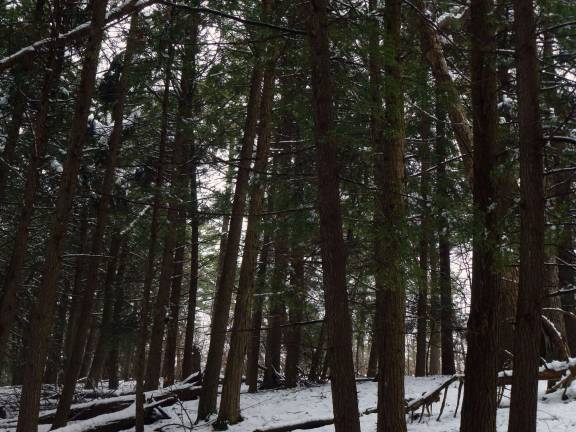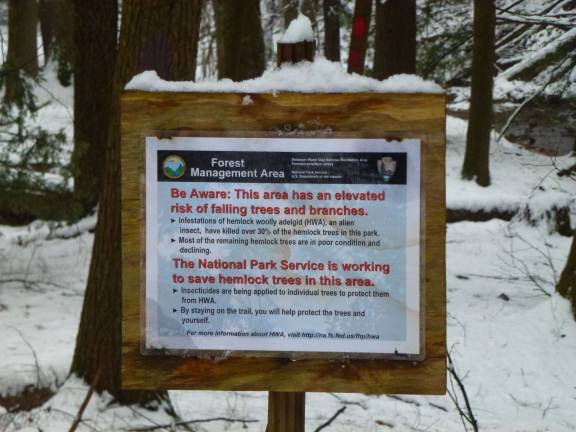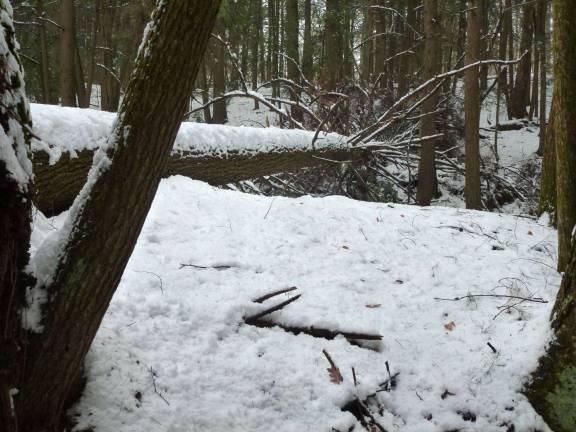Scrambling to save state's hemlocks from invaders



By DON HOPEY
PITTSBURGH (AP) — Foresters are looking for an eastern hemlock version of Superman.
Their search for a “bulletproof" genetic strain of Pennsylvania's state tree is an important part of a new, multi-branched plan to save as many of the stream-shading evergreens as possible from an invasive and voracious Asian insect, the hemlock woolly adelgid.
The hemlock conservation plan, released Nov. 21 by the state Department of Conservation and Natural Resources, also will continue the already steep ramp-up of pesticide use in high-value trees and tree stands, and the release of predatory beetles to eat the adelgids.
“Pennsylvania's state tree is under deadly attack by the hemlock woolly adelgid," said DCNR Secretary Ellen Ferretti, “and our Bureau of Forestry has mounted a comprehensive and science-based battle plan that addresses both the non-native, invasive insect and the invaluable forest species it is killing."
The state agency has allocated almost $500,000 for hemlock preservation this year, compared with just $17,000 in 2013.
Donald Eggen, chief of the agency's forest pest management division, said pesticides, which have been used since 2004, provide a short-term response to adelgid infestations. The introduction of the predatory beetles and research targeting pest-resistant hemlocks are promising, long-term approaches.
He said scientists are already studying the genetics of a less-than-2-acre hemlock grove in New Jersey that has survived multiple waves of adelgid infestation.
“Maybe those pest-resistant trees might make up 1 percent of all the hemlocks. We call them bulletproof," Eggen said. “And they may be our best bet, long term, to preserve select hemlock habitats."
Hemlocks are a slow-growing tree species that can eventually reach great heights. They grow to 175 feet tall and can live up to 900 years. According to the U.S. Forest Service they fill an important ecological role, providing shade to cool streams where native brook trout live, wildlife cover, forest aesthetics and recreational opportunities.
While hemlocks make up less than 10 percent of the Appalachian forest, Eggen said that where they do exist they are a “foundation species," meaning that everything else that lives near those trees, plant or animal, exists because of the hemlock.
An accidental plague
The hemlock woolly adelgid — or HWA for short — has been munching its way through the Appalachian's hemlock habitats since the 1950s when, according to the Forest Service, it was accidentally brought into the country from Asia, most likely in a shipment of plants.
Adelgids don't fly but their sticky egg sacks move from tree to tree by attaching to humans or animals and especially birds.
The sap-sucking insects feed on new growth branches, draining the life out of the trees. They lay their eggs on the underside of the flat hemlock needles, and their name comes from a white waxy egg coating that resembles a tiny tuft of wool.
The bugs, which have moved in waves from the southern Appalachians toward the north and west, already have wiped out all of the hemlock in the Great Smoky Mountain National Park, and 95 percent of those in Shenandoah National Park in Virginia.
In Pennsylvania, infestations have been found in 58 of the state's 67 counties.
“The scale of the problem is pretty big," said Rick Turcotte, a U.S. Forest Service entomologist in Morgantown, W.Va., who has worked with state officials on the hemlock conservation plan. “They have to decide where in the state the trees are most important for ecological or historical reasons. Due to cost, we're looking at targeting those trees."
Focus on high-priority trees
Ground zero in the state's battle to preserve the hemlock is Cook Forest State Park, on the borders of Clarion, Jefferson and Forest counties.
The adelgid was first discovered in the park in March 2013, and park manager Ryan Borcz said park employees and volunteers, along with the Forest Service and the Nature Conservancy, have been working feverishly to keep the adelgid from infesting the “Forest Cathedral" and 10 other old growth areas covering more than a quarter of the park's 8,500 acres.
The hemlocks in those areas are among the oldest and largest in the eastern U.S. and include the famous Seneca Hemlock, which stands 147 feet tall, has a 4-foot-diameter trunk and is approximately 350 years old.
“Our approach is to actively treat with pesticides as many high-priority trees as we can. The Seneca Hemlock was the first," said Borcz, adding that 1,000 of the adelgid-eating beetles also were released last year and another release is planned soon, weather permitting.
“We know we have the HWA. But we found it in the very early stages and we have time to respond. Cold winter temperatures the last two years have caused increased adelgid mortality and slowed their spread. This is not a helpless scenario."
Borcz said park employees dedicated one day a week through the summer and fall to hemlock conservation work, and more than 100 people, including volunteers, participated in treating 2,155 hemlocks, all old-growth trees.
The natural resources officials are asking for public input to identify and suggest high-value hemlock stands where the tree preservation efforts should be focused, as well as any hemlocks that appear to be resistant to the adelgid in infested areas.
Focus area suggestions must be submitted to DCNR's Bureau of Forestry by Dec. 15 at the email address ranreasternhelmlock(at)pa.gov.
Eggen said he's optimistic that a state strategy focusing on high-value hemlock stands will succeed, unless freezing temperatures are eliminated by a warming climate.
“We will be able to preserve the eastern hemlock," he said. “Will they be as abundant everywhere 10 or 15 or 20 years from now? No, they will be highly impacted. But they will survive as much as cold winters will allow.
“The worst-case scenario is climate change causes our winters to warm up and the winters don't kill off the adelgids. Then we'll look like the Blue Ridge in Virginia where there's not one hemlock — where there's 100 percent mortality."